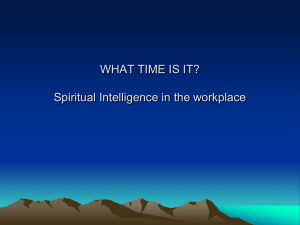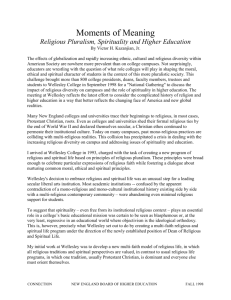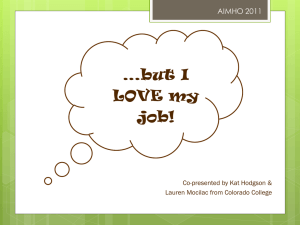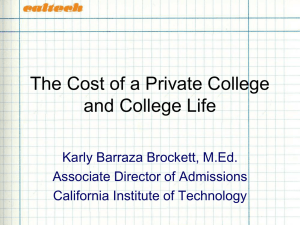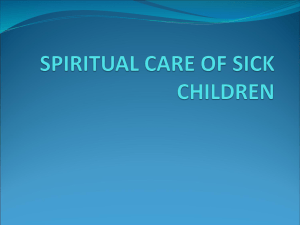Religious Identity and Intellectual Development: Forging Powerful
advertisement
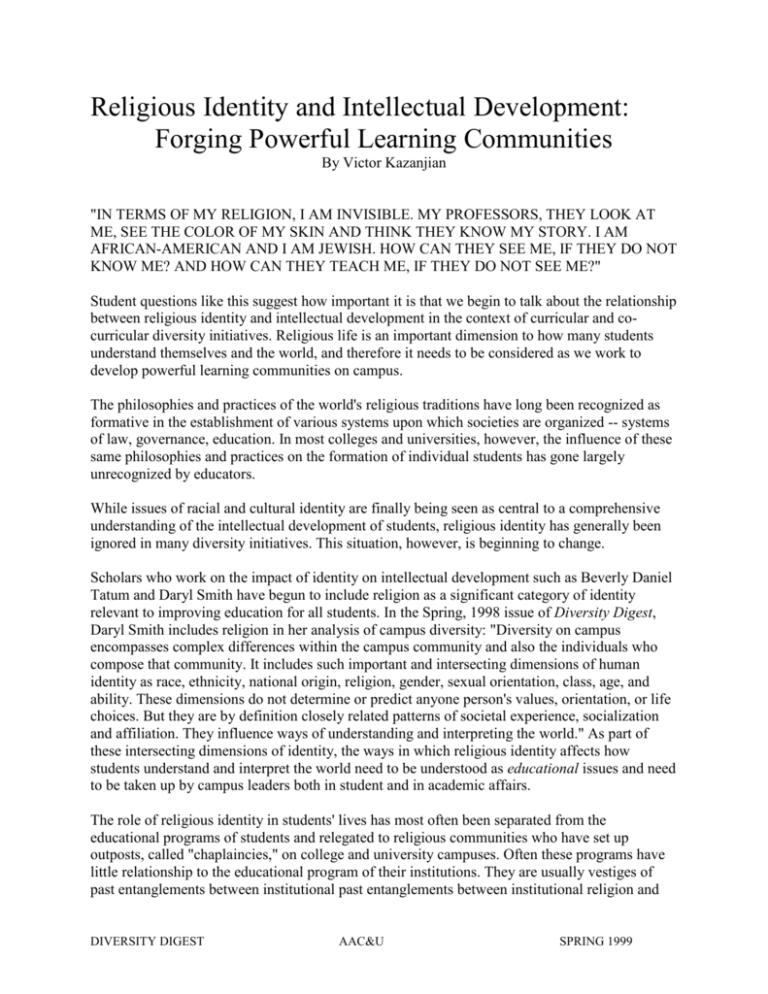
Religious Identity and Intellectual Development: Forging Powerful Learning Communities By Victor Kazanjian "IN TERMS OF MY RELIGION, I AM INVISIBLE. MY PROFESSORS, THEY LOOK AT ME, SEE THE COLOR OF MY SKIN AND THINK THEY KNOW MY STORY. I AM AFRICAN-AMERICAN AND I AM JEWISH. HOW CAN THEY SEE ME, IF THEY DO NOT KNOW ME? AND HOW CAN THEY TEACH ME, IF THEY DO NOT SEE ME?" Student questions like this suggest how important it is that we begin to talk about the relationship between religious identity and intellectual development in the context of curricular and cocurricular diversity initiatives. Religious life is an important dimension to how many students understand themselves and the world, and therefore it needs to be considered as we work to develop powerful learning communities on campus. The philosophies and practices of the world's religious traditions have long been recognized as formative in the establishment of various systems upon which societies are organized -- systems of law, governance, education. In most colleges and universities, however, the influence of these same philosophies and practices on the formation of individual students has gone largely unrecognized by educators. While issues of racial and cultural identity are finally being seen as central to a comprehensive understanding of the intellectual development of students, religious identity has generally been ignored in many diversity initiatives. This situation, however, is beginning to change. Scholars who work on the impact of identity on intellectual development such as Beverly Daniel Tatum and Daryl Smith have begun to include religion as a significant category of identity relevant to improving education for all students. In the Spring, 1998 issue of Diversity Digest, Daryl Smith includes religion in her analysis of campus diversity: "Diversity on campus encompasses complex differences within the campus community and also the individuals who compose that community. It includes such important and intersecting dimensions of human identity as race, ethnicity, national origin, religion, gender, sexual orientation, class, age, and ability. These dimensions do not determine or predict anyone person's values, orientation, or life choices. But they are by definition closely related patterns of societal experience, socialization and affiliation. They influence ways of understanding and interpreting the world." As part of these intersecting dimensions of identity, the ways in which religious identity affects how students understand and interpret the world need to be understood as educational issues and need to be taken up by campus leaders both in student and in academic affairs. The role of religious identity in students' lives has most often been separated from the educational programs of students and relegated to religious communities who have set up outposts, called "chaplaincies," on college and university campuses. Often these programs have little relationship to the educational program of their institutions. They are usually vestiges of past entanglements between institutional past entanglements between institutional religion and DIVERSITY DIGEST AAC&U SPRING 1999 institutions of higher education and therefore are looked upon as either irrelevant or antithetical to contemporary secular education. Where religious programs do exist, they provide services to students from those traditions which have been recognized in American society -- varieties of Christian denominations and on occasion the Jewish community as well. But American colleges and universities are diversifying at an incredibly rapid rate. Muslims, Hindus, Buddhists, Jains, Sikhs, and Baha'is are increasing in numbers on campuses across the country posing new questions about the impact of religious diversity on campus life and the role of religious identity and spirituality in the educational process. Inspired by the development of new models for incorporating religious and spiritual life into the educational program at institutions such as Wellesley College and Brown University, a national group of educators invited presidents, chancellors, deans, faculty, administrators, students, alumni, trustees, and religious life professionals from colleges and universities across the country to a two-day symposium entitled "EDUCATION as Transformation: Religious Pluralism, Spirituality and Higher Education," held on the Wellesley College campus this past September. More than 800 individuals from 250 colleges and universities attended, including 28 college and university presidents together with scores of faculty members, administrators, students, and religious life professionals. In response to the remarkable interest shown by participants at the national gathering, the EDUCATION as Transformation Project, located at Wellesley College, has emerged as a national focal point for the exchange of ideas, information, and training around issues of religious diversity and spirituality in higher education. The Project is currently in contact with representatives from more than 400 colleges and universities across the country providing them with educational materials, consultation, workshops, and seminars through which they can begin to develop strategies to address these issues on their campuses. One of the goals of this project is to explore the impact of religious diversity on higher education and develop strategies to address: 1) the dramatic growth of religious diversity in American colleges and universities, and 2) the desire of educational institutions to prepare their students for a religiously diverse world. The project will take the research and theory on religious identity, put it into practice, test it, and facilitate the creation of new models of religious life on campuses. The Project seeks to define education as a transformational process. Through it, students are educated to be global citizens with an understanding of the diversity of religious traditions and strategies to engage this diversity in creative and productive ways. Another goal of the project is to consider the role of spirituality at colleges and universities. It will examine spirituality's relationship to teaching and learning issues, the cultivation of values, students' moral, ethical, and intellectual development, and the fostering of global learning communities. By incorporating the research and theory on spirituality and education into discussions about the educational programs of colleges and universities and by piloting programs in participating DIVERSITY DIGEST AAC&U SPRING 1999 institutions, the Project seeks to define a student's religious/spiritual development as critical to her/his intellectual development. As educational institutions consider how best to prepare students for life and leadership in an increasingly interdependent world, including religious identity in their diversity initiatives is crucial to their becoming effective learning communities. Wellesley College's President, Diana Chapman Walsh, describes her college's religious and spiritual life program as affirming "the understanding of a liberal arts education as a spiritual journey as well as an intellectual one. We are reaching toward a future in which managing the new global realities will require the ability to move from culture to culture, to collaborate and communicate with fluency across national, racial, religious and socioeconomic lines, and to appreciate diversity as a vital resource for learning and growth. Wellesley College's Religious and Spiritual Life Program In 1993, Wellesley College initiated a new Religious and Spiritual Life Program based on principles of religious pluralism in which all particular expressions of religious faith are celebrated and in which dialogue about common moral, ethical, and spiritual principles is nurtured. Wellesley now has a multi-faith program led by the Dean of Religious and Spiritual Life and a team of advisors and student leaders from a wide array of faiths, including the Baha'i, Buddhist, Christian (Evangelical, Orthodox, Protestant, and Roman Catholic), Hindu, Jain, Jewish, Muslim, Native African, Native American, Pagan, Sikh, Taoist, Unitarian Universalist, and Zoroastrian traditions. These leaders work together to develop new models for religious life and community ritual in which each religious tradition is respected and in which no one voice dominates. Through this program, students and faculty at Wellesley have begun to explore questions about integrating the spiritual dimensions of their lives into their learning. The project aims to bridge the gap between intellectual development and emotional, social, and spiritual development. Students and faculty have participated in a series of workshops exploring transformational moments in the classroom in which they describe moments of meaning, inspiration, connection, wonder, and awe. We are examining to what degree these moments constitute a spiritual dimension within a student's overall educational experience. Dean of Religious and Spiritual Life, Victor Kazanjian hopes this initiative can "find an educational language to describe the transformational process that is already happening in the classroom which is more than simply the passing on of information." DIVERSITY DIGEST AAC&U SPRING 1999

